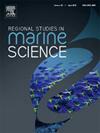Modelling the abundance of key aquatic species in a tropical Indian estuary using biotic and abiotic predictors
IF 2.1
4区 环境科学与生态学
Q3 ECOLOGY
引用次数: 0
Abstract
Species distribution modelling (SDM) is a method that assists in linking the biotic and abiotic features of the ecosystems. In this study, we developed SDMs for total fish abundance, abundance of Escualosa thoracata (ET), Mugil cephalus (MC), Sardinella longiceps (SL) and Fenneropenaeus merguiensis (FM) based on biotic and abiotic variables using multivariate statistical techniques such as Regression tree (RT), Support Vector Machine (SVM), K-nearest neighbours (kNN), Gaussian process regression (GPR), Random Forest (RF), eXtreme Gradient Boosting (XGB), Cubist, and Quantile random forest (QRF). A combination of abiotic and biotic variables such as salinity, temperature, mud, turbidity, zooplankton, shell debris, sand, and benthos were identified as the significant predictors for the distribution of total fish abundance and species wise fish abundance. The model performance was evaluated based on coefficient of determination (R2), d-index, mean bias error (MBE), Nash–Sutcliffe efficiency (NSE) and root mean squared error (RMSE). A unique average ranking procedure was followed using all the model evaluation indicators to select a best model for a given season or species. The top performing models did not vary much between the seasons and species. We identified the following models performed best for different species respectively during postmonsoon and premonsoon seasons- Cubist and QRF for E. thoracata, RF and GLMNET for M. cephalus, SVM and QRF for S. longiceps, GPR and QRF for F. merguiensis. The major variables influenced the species distribution were benthic substratum (sand, mud, shell debris), chlorophyll-a and depth. Thus, it is evident that though the other variables also influence the distribution and abundance of the species in an estuarine bay, the benthic features, depth and morphometry can have significant effect on the species distribution. Moreover, the advanced multivariate statistical tools can aid in the prediction of the species distribution in the tropical estuaries.
求助全文
约1分钟内获得全文
求助全文
来源期刊

Regional Studies in Marine Science
Agricultural and Biological Sciences-Ecology, Evolution, Behavior and Systematics
CiteScore
3.90
自引率
4.80%
发文量
336
审稿时长
69 days
期刊介绍:
REGIONAL STUDIES IN MARINE SCIENCE will publish scientifically sound papers on regional aspects of maritime and marine resources in estuaries, coastal zones, continental shelf, the seas and oceans.
 求助内容:
求助内容: 应助结果提醒方式:
应助结果提醒方式:


